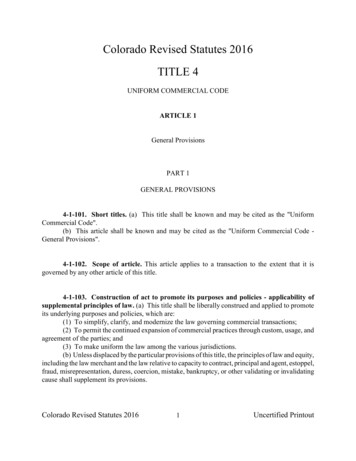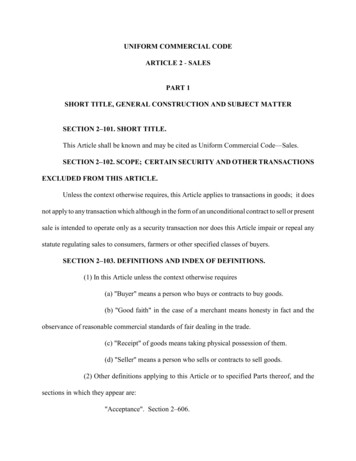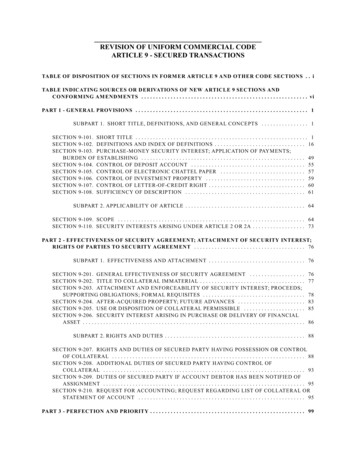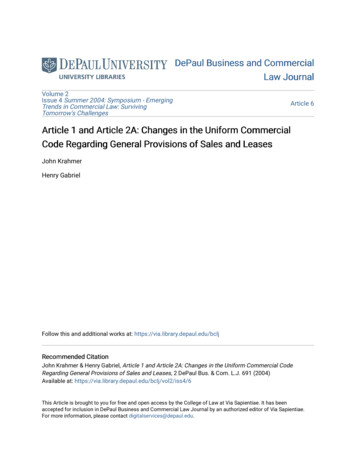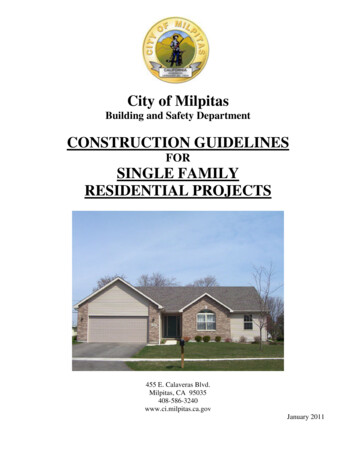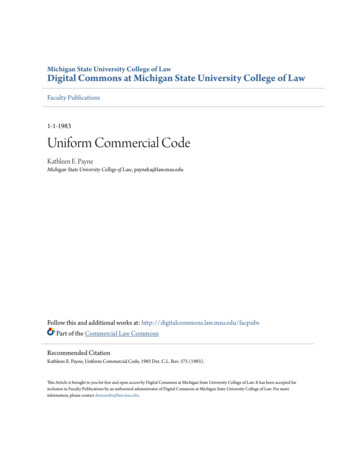
Transcription
Michigan State University College of LawDigital Commons at Michigan State University College of LawFaculty Publications1-1-1983Uniform Commercial CodeKathleen E. PayneMichigan State University College of Law, payneka@law.msu.eduFollow this and additional works at: http://digitalcommons.law.msu.edu/facpubsPart of the Commercial Law CommonsRecommended CitationKathleen E. Payne, Uniform Commercial Code, 1983 Det. C.L. Rev. 575 (1983).This Article is brought to you for free and open access by Digital Commons at Michigan State University College of Law. It has been accepted forinclusion in Faculty Publications by an authorized administrator of Digital Commons at Michigan State University College of Law. For moreinformation, please contact domannbr@law.msu.edu.
UNIFORM COMMERCIAL CODEKathleen E. PaynetI.INTRODUCTIONThree Uniform Commercial Code Article 2 and two Article 9 issues are presented by the commercial transaction cases decidedduring the survey period between October 1, 1981 to October 1,1982. The Sixth Circuit Court of Appeals addressed the frequentlylitigated and troublesome issues of what constitutes timely and adequate notice of breach, whether reliance is a necessary element ina breach of express warranty action, and the effect of the impliedgood faith term in a contract containing a termination at willclause. In the personal property security arena, the cases presentedthe questions of resolving priorities between conflicting purchasemoney secured parties and of applying U.C.C. section 9-103 to determine the validity of a perfected out-of-state security interest.The Article 2 cases were decided as diversity cases since the Uniform Commercial Code provisions have not been enacted by theUnited States Congress as general federal statutory law. Accordingly, in interpreting and applying Code language, the federalcourt first looks to the appropriate state law. Only in the absenceof guidance from the forum state's highest court or its state legislature is the federal court charged to decide unsettled issues of statelaw by analyzing the indications and determining the path thestate court would follow.II.A.SALESNotice of BreachThe vexatious and frequently litigated question of what constitutes timely and sufficient notice of breach to preserve the buyer'sremedies against the seller under U.C.C. section 2-607 (3)(a) ispresented by the case of K & M Joint Venture v. Smith International, Inc! The standard enunciated in K & M Joint Venture ist J.D., Detroit College of Law, 1977; L.L.M., University of Michigan, 1981; Associate Professor of Law, Detroit College of Law. The author gratefully acknowledges the research assistance of Laura L. Ritzman.1. 669 F.2d 1106 (6th Cir. 1982).HeinOnline -- 1983 Det. C.L. Rev. 575 1983
576Detroit College of Law Review[2:575significant for two reasons. First, the standard has been quoted approvingly and applied by a different Sixth Circuit panel in a percuriam opinion, summarily affirming a summary judgment dismissal entered by the district court.! Second, and more importantly, itmay be interpreted as establishing a stricter standard for notification of breach and assertion of legal rights to satisfy V.C.C. section2-607 than was adopted by the well received Fifth Circuit case3upon which K & M Joint Venture is based.In this case, plaintiff, K & M Joint Venture (K & M), purchaseda twelve foot diameter tunnel boring machine (TBM) from theCalweld Division of defendant, Smith International, Inc. (Calweld).The TBM was to be sued for a sewer project in Cleveland. It isundisputed that the TBM malfunctioned repeatedly from June 25,1974, the date upon which the machine was first used on the sewerproject, until it was removed for extensive repair on January 8,1975. During this period, K & M was in frequent contact with defendant, seeking advice and voicing complaints. On one such occasion in July, K & M expressed an intention to hold Calweld responsible for the breakdown. On January 23, 1975, K & M advisedCalweld that it planned to completely rebuild the TBM and requested a full set of drawings. During the rebuilding,· K & M discovered a number of discrepancies between the drawings and theactual construction of the TBM. Eleven months later, plaintifffiled an action for breach of warranty.The Vnited States District Court for the Northern District ofOhio, in a bench trial, awarded damages of approximately 1.5 million dollars.· The district court found that the seller had breachedthe implied warranty of merchantibility under V.C.C. section 2314, since the machine was so defective that it required completerebuilding. 6Defendant appealed from this decision, raising two issues. First,2. Running Spring Associates v. Masonite Corp., 680 F.2d 469 (6th Cir. 1982). The summary judgment was based upon the plaintiff-buyer's failure to establish the requisite timelyand sufficient notice of breach required by Ohio Revised Code § 1302.65(c), which is theOhio legislature's enactment of Uniform Commercial Code § 2-607(3)(a). The facts are notset forth in the per curiam opinion, accordingly, this author does not know what notice, ifany, was given by the buyer.3. Eastern Airlines, Inc. v. McDonnell Douglas Corp., 532 F.2d 957 (5th Cir. 1976).4. 669 F.2d at n08.5. [d. at 1108-09.HeinOnline -- 1983 Det. C.L. Rev. 576 1983
1983]Uniform Commercial Code577that the TBM was sold without warranties and, second, that plaintiff failed to timely notify the defendant of the breach of warranty.This second issue and its resolution may prove troublesome topractitioners in the future.With regard to the first issue, defendant contended that theTBM was sold "as is," and that use of this language was intendedto exclude all implied warranties under the Uniform CommercialCode. The district court, however, found that the seller's use of theterm "as is" simply meant that Calweld was unwilling to incur further selling expenses, such as cleaning up the accessories or including additional parts. 6 The Sixth Circuit Court of Appeals affirmedas to this issue.The court noted that, while the language "as is" can be used todisclaim implied warranties, including the implied warranty ofmerchantability, such language does not exclude these warrantiesautomatically. In support, the court cited U.C.C. section 2-316(3)(a), which states in relevant part: "Unless the circumstances indicate otherwise," all implied warranties are excluded by expressions like 'as is,' 'with all faults' or other language which in common understanding calls the buyer's attention to the exclusion ofwarranties and makes plain that there is no implied warranty. "7The court then found that the district court did not err in determining that, in this case, the "circumstances indicated otherwise,"that is, that the use of "as is" was not intended to exclude theimplied warranties.Calweld next contended that the district court erred in findingthat the plaintiff notified defendant of the breach within a reasonable time. Plaintiff argued that notice is a question of fact and thatthe district court's finding that K & M gave adequate and timelynotice was not clearly erroneous. The Sixth Circuit disagreed andreversed on this issue. The court stated that whether notice wasgiven, and of what it consisted, were questions of fact but thequestion of whether the notice satisfied the statutory requirementwas one of law. 8 Thus, the court held that notice under U.C.C. section 2-607 (3)(a) is a mixed question of fact and law. As such, the6. Id. at 1109.7. Id. at 1110.8. Id. at 1111.HeinOnline -- 1983 Det. C.L. Rev. 577 1983
578Detroit College of Law Review[2:575reviewing court is not bound by the clearly erroneous standard. 9The court found that the district court erred, in regarding ascontrolling the sentence from comment 4 to U.C.C. section 2-607which states that "[t]he content of the notification need merely indicate to the seller that the transaction is still troublesome andmust be watched." Following language set forth in the Fifth Circuit case of Eastern Airlines v. McDonnell Douglas Corp.,10 theSixth Circuit panel held that merely indicating that a transactionis troublesome is not sufficient to constitute notice. UnderpinningU.C.C. section 2-607 is a requirement of commercial good faithwhich is met by prompt notice that the transaction is claimed toinvolve a breach. In finding that K & M did not, as a matter oflaw, timely notify the defendant, the court stated that K & M didnot give actual notice of breach until the cause of action was filedsome seventeen months after the first problems were experiencedwith the TBM.11Judge Holschuh dissented, stating that deference should havebeen given to the district court's determination of the timelinessand adequacy of notice.llI The dissent noted that whether propernotice has been given has been treated as a question of fact in numerous decisions, including Standard Alliance v. Black Clawson,13a 1978 Sixth Circuit case. The dissent then conceded that thequestion could be viewed as a mixed one of fact and law, as it in9. The majority opinion backs away from this mixed question of fact and law standardin a footnote addressed to the dissent:The dissent is concerned that we have not dealt properly with the findings of thedistrict court on the issue of the adequacy and timeliness of notice. After carefulexamination of the record on appeal, the majority concludes that even if the findings with respect to notice were purely factual, it would be necssary to reversethem under the "clearly enoneous" standard of Rule 52 (a).Id. at 1112. This footnote may provide a future loophole to the Sixth Circuit for accomodating the inconsistent positions of the instant case and the case of Standard Alliance v. BlackClawson Co., 587 F.2d 813 (6th Cir. 1978), which held that "[wJhether proper notice wasgiven was a question of fact." 587 F.2d at 823.10. 532 F.2d at 757. The instant case is a diversity action involving an Ohio buyer and aCalifornia seller contractually bound by a term requiring that contract provisions be construed in accordance with California law. In the Eastern Airlines case, the Fifth Circuit wasrequired to and did apply California law in interpreting the notice requirements of U.C.C. §2-607. Thus, the Sixth Circuit panel's reliance on the Eastern Airlines case was appropriately placed.11. 669 F.2d at 1114-15.12. Id. at 1116 (J. Holschuh, dissenting).13. 587 F.2d at 813.HeinOnline -- 1983 Det. C.L. Rev. 578 1983
1983]Uniform Commercial Code579volved application of a legal standard, and therefore the court isnot bound by the clearly erroneous rule. If, as in this case, however, a district court judge applies a correct legal standard and hisconclusion is supported by substantial evidence in the record andis not unreasonable, then the decision should be affirmed. 14The dissent indicated that there was no disagreement among thepanel members as to the interpretation of the notice provision ofV.C.C. section 2-607. The dissenting judge agreed that V.C.C. section 2-607 requires more than notifying the seller that the transaction is troublesome. The majority and dissent part company in answering whether the district judge accepted the sentencepreviously quoted from comment 4 as controlling. The dissent argued that the district court did not rely upon limited commentlanguage and, therefore, did not apply an erroneous legal standard.To the contrary, the dissent emphasized that the district courtcorrectly discussed all of the purposes underlying the notice requirement and evaluated the plaintiff's conduct when taken as awhole as constituting adequate notice of breach. Iii The districtcourt viewed the facts differently from the majority, finding thatthe plaintiff continually complained to the defendant aboutproblems with the TBM. According to the dissent, the districtcourt found the requisite notice of breach in a K & M statement toCalweld's service representative, less than one month after the firstinstallation of the TBM, that K & M intended to hold Calweld14. 669 F.2d at 1119. In so concluding, the dissent stated that giving deference to a trialcourt's application of a correct legal standard recognizes that the lower court is in a betterposition to make evidentiary findings based upon the record presented. Such recognitionpreserves the proper relationship between trial courts and appellate courts. The dissentwent on to quote from Ashland Oil and Refining Co. v. Kenny Construction Co., 395 F.2d683 (6th Cir. 1968), in which the court approved a standard of review of a "mixed finding"that gives deference to the lower court's conclusions:If (the court's determination is] regarded as a mixed finding, the application oflegal principles was involved in making the determination, and it is therefore subject to review free from the clearly erroneous rule. See Taft Broadcasting Co. v.Columbus· Dayton Local, 297 F.2d 149 (6th Cir. 1961); Cordovan Associates, Inc. v.Dayton Rubber Co., 290 F.2d 858 (6th Cir. 1961). Plaintiff does not contend, nordo we find, that the District Court applied an incorrect principle of law to thefact, and while that court's determination is not the only one permissible underthe facts, it is supported by substantial evidence and is not unreasonable. Accordingly, the judgement of the District Court should be affirmed.669 F.2d at 1119 (quoting Ashland Oil, 395 F.2d at 684).15. 669 F.2d at 1121.HeinOnline -- 1983 Det. C.L. Rev. 579 1983
580Detroit College of Law Review[2:575responsible for the breakdowns. 18 The distinction between the district court and Sixth Circuit decisions is the weight given to thisearly statement in informing Calweld of the breach. The problemthus posed by this case for the practitioner is what constitutestimely and reasonable notice from both a counseling and litigationstandpoint.A buyer, who seeks recovery from a seller for a claimed breach ofwarranty, must give the seller prompt notice of his claim. U.C.C.section 2-607 (3)(a) provides that "(3) [w]here a tender has beenaccepted (a) the buyer must within a reasonable time after he discovers or should have discovered any breach notify the seller ofbreach or be barred from any remedy." Moreover, inasmuch as section 2-607 operates as a condition precedent to any recovery, theplaintiff bears the burden of proof to show not only that notice wasgiven within a reasonable time,17 but also, that the notice was adequate to inform the defendant he was in breach.What constitutes a reasonable time within which the buyershould have discovered any breach and notified the seller is a frequently litigated question. The cases certainly do not provide aworkable rule or formula. For example, notice after two month hasbeen held unreasonable l8 while notice after two and one-half yearshas been held timely. 19Thus, while case law is not helpful in evaluating timeliness, oneof the policies underlying the notice requirement is particularlyhelpful in predicting how a court· may apply the reasonable timerequirement. so A major reason for requiring notice is that it opensthe way for normal settlement through negotiations, providing anopportunity for the seller to suggest cure and for the buyer to min[d. at 1122.17. Standard Alliance, 587 F.2d at 823, citing Ehlers v. Chrysler Motor Corp., 226N.W.2d 157, 159 (S.D. 1975); Schnabl v. Ford Motor Co., 54 Wis. 2d 354, 198 N.W.2d 161(1972).18. Hays Merchandise, Inc. v. Dewey, 78 Wash. 2d 343, 474 P.2d 270 (1970).19. Lewis v. Mobil Oil Corp., 438 F.2d 500, 508-09 (8th Cir. 1971).20. Treatise authors White and Summers indicate that two other policies behind U.C.C.§ 2-607 can be identified. The second policy is to afford the seller the opportunity to preparefor negotiation and litigation. The third and least important policy "is to give the defendantthat same kind of mind balm he gets from the statute of limitations. There is some value inallowing a seller, at some point, to close his books on goods sold in the past and to pass onto other things." J. WHITE & R. SUMMERS, HANDBOOK OF THE LAW UNDER THE UNIFORMCOMMERCIAL CODE 422 (1980).16.HeinOnline -- 1983 Det. C.L. Rev. 580 1983
1983]Uniform Commercial Code581imize losses. 21 Accordingly, where a buyer is held to have forfeitedCode remedies by failing to give timely notice, the court has generally found bad faith on the part of the buyer. This commercial badfaith is found in the buyer's failure to give seller an opportunity tocure the breach.Timeliness, therefore, may depend completely upon whether thepassage of time increases the damages incurred and whether theseller, with notice of the breach, could have reduced the damagesthrough an opportunity to cure by adjustment or replacement. Applying this standard to K & M Joint Venture, the notice given toCalweld's service representative within one month from first useappears timely; however, the notice given by filing suit seventeenmonths after the first problems were experienced appears inconsistent with the underlying policy considerations and, therefore,untimely.The more difficult question posed by the instant case is determining what constitutes sufficient notice under U.C.C. section 2607. There is a split of authority as to what constitutes adequatenotice. The statutory language merely requires that the buyer "notify the seller of breach or be barred from any remedy."22 No standard of adequacy of notice is provided. Thus, to delineate a standard, courts and commentators have relied upon the officialcomments accompanying the Code provision. Comment 4 to U.C.C.section 2-607 provides in pertinent part:The content of the notification need merely be sufficient to let the sellerknow that the transaction is still troublesome and must be watched.There is no reason to require that the notification which saves thebuyer's rights under this section must include a clear statement of all theobjections that will be relied on by the buyer, as under the section covering statements of defect upon rejection (§2-605). Nor is there reason forrequiring the notification to be a claim for damages or of any threatenedlitigation or other resort to a remedy. The notification which saves thebuyer's rights under this article need only be such as informs the sellerthat the transaction is claimed to involve a breach, and thus opens theway for normal settlement through negotiation.The problem presented is whether the Code drafters intendedU.C.C. section 2-607 to eliminate the technical notice requirementsof its predecessor, section 49 of the Uniform Sales Act. Under sec21.22.[d. at 421.U.C.C. § 2-607(3)(a) (1978).HeinOnline -- 1983 Det. C.L. Rev. 581 1983
582Detroit College of Law Review[2:575tion 49, it was irrelevant whether a seller had actual knowledge ofa non-conforming tender. Instead, the critical question waswhether the seller had been informed that the buyer consideredthe seller to be in breach. In a pre-Code case, therefore, applyingthe Uniform Sales Act provision, Judge Learned Hand presentedthe following standard which was subsequently quoted as authoritative on section 49:The plaintiff replies that the buyer is not required to give notice of whatthe seller already knows, but this confuses two quite different things.The notice "of the breach" required is not of the facts, which the sellerpresumably knows quite as well as, if not better than, the buyer, but ofbuyer's claim that they constitute a breach. The purpose of the notice isto advise the seller that he must meet a claim for damages, as to which,rightly or wrongly, the law requires that he shall have early warning. 28The notice standard developed under section 49 required that thebuyer make a specific claim for damages. Moreover, some jurisdictions required the buyer to specify, in detail, the basis of his claimthat the contract was breached. UClearly, some of the technical requirements of section 49 are dispensed with under the Code provision. As noted in the Code comments, "[t]here is no reason to require that the notification which·saves the buyer's rights under this section must include a clearstatement of all the objections."u Further, the drafters intended toeliminate the technical requirement of a specific claim for damages, stating that "[n]or is there reason for requiring the notification to be a claim for damages or of any threatened litigation orother resort to a remedy."1I8Relying on certain portions of Code comment 4, some courts andcommentators adopted the view that almost any kind of notice ofdissatisfaction is sufficient.17 Clearly the drafters intended a loosetest; a scribbled note on a bit of toilet paper will do. lIS Nor is ascribbled note required. The law seems well established that oral23. American Mfg. Co. v. United States Shipping Board E. F. Corp., 7 F.2d 565, 566 (2dCir. 1925).24. See, e.g., Idzykowski v. Jordon Marsh Co., 279 Mass. 163, 181 N.E. 172, 173 (1932).25. U.C.C. § 2-607 comment 4 (1978).26. [d.27. See, e.g., Lewis v. Mobil Oil Corp., 438 F.2d 500, 509 (8th Cir. 1971); Metro Investment Corp. v. Portland Rd. Lumber Yard, Inc., 263 Ore. 76, 501 P.2d 312 (1972).28. See supra note 20, at 425.HeinOnline -- 1983 Det. C.L. Rev. 582 1983
1983]Uniform Commercial Code583notification satisfies the notice requirement. 29 Some courts have indicated that certain events, such as the seller's representativesviewing the product's inability to properly function,30 are sufficientto constitute notice to the seller.Other courts, however, require something more than the minimalnotification endorsed by the authorities cited above. The focalpoint of jurisdictions requiring a more stringent standard appearsgenerally to be the final sentence in Code comment 4 to U.C.C.section 2-607: "The notification . need only be such as informsthe seller that the transaction is claimed to involve a breach, andthus opens the way for normal settlement through negotiation."The notice must inform the seller that the buyer regards the contract as breached. Courts interpret this as conforming with thestandard established by Judge Learned Hand in 1925 and, thus,indirectly engraft back the flavor of Uniform Sales Act section 49.Eastern Airlines,3l heavily relied upon in K & M Joint Venture, issuch a case.Eastern Airlines involved a series of contracts by which McDonnell Douglas32 agreed to manufacture and sell to Eastern ninetynine jet planes for approximately one-half billion dollars. Althoughvarying in details, all the agreements required McDonnell Douglasto manufacture planes at a stipulated price per aircraft, with eachjet designated for delivery during a particular calendar month.Throughout the duration of the contracts, Eastern Airlines encountered delivery delay problems. Several months after the finaldelivery, Eastern wrote McDonnell Douglas, presenting a claim fordamages resulting from the late deliveries which occurred over theprevious three years. 33 The airline alleged that the delays could not29. See, e.g., Page v. Camper City & Mobile Home Sales, 292 Ala. 562, 297 So.2d 810(1974); Jay v. Zimmerman Co., 327 F. Supp. 1198 (E.D; Mo. 1971); VLN Corp. v. AmericanOffice Equipment Co., 536 P.2d 863 (Colo. App. 1975); Smith v. Butler, 19 Md. App. 467,311 A.2d 813 (1973); Oregon Lumber Co. v. Dwyer Overseas Timber Products Co., 280 Or.437, 571 P.2d 884 (1973).30. See, e.g., Boeing Airplane Co. v. O'Malley, 329 F.2d 585 (8th Cir. 1964).31. See supra note 10 and accompanying text.32. Eastern originally contracted with Douglas Aircraft, Inc., however, during the performance of the contracts, Douglas faced a financial crisis requiring merger with a solventpartner. McDonnell Aircraft Company was selected. After McDonnell infused over sixtyeight million dollars in new funds into Douglas, a merger was consummated, and the newMcDonnell-Douglas Corporation assumed all the obligations and liabilities of the formerDouglas Aircraft Company.33. 532 F.2d at 964. On the average, each of the ninety late planes was delivered eightyHeinOnline -- 1983 Det. C.L. Rev. 583 1983
584Detroit College of Law Review[2:575be deemed excusable under the applicable clause in the agreements. McDonnell Douglas rejected the claim and suit resulted. Ajury awarded Eastern damages of approximately 25 million dollarsand McDonnell Douglas appealed.McDonnell Douglas contended, inter alia, that Eastern hadfailed to give timely and adequate notice of the breaches. The district court ruled against McDonnell Douglas on this issue, holdingthat Eastern need not prove, as a predicate for recovery, that ithad given McDonnell Douglas reasonable and timely notice ofbreach caused by the delivery delays.34 The trial court found thenotice requirement of V.C.C. section 2-607 inapplicable to deliverydays because the seller necessarily has knowledge of this type ofcontract violation. Notice serves no purpose and, accordingly, isunnecessary where a breach is apparent to both parties. 311The Fifth Circuit found error and reversed, ruling that the question of timely and adequate notice under V.C.C. section 2-607should have been submitted to the jury.3S Given the desirable purposes of encouraging compromise and promoting good faith incommercial relations, it is not enough under V.C.C. section 2-607that a seller has knowledge of the facts constituting a non-conforming tender; seller must also be informed that buyer considersseller to be in breach of the contract. The V.C.C. notice requirement is applicable to delivery delays as well as other breaches,thus, the trial court erred in failing to apply the Code provision. 37Alternatively, the trial court ruled that Eastern's notice was bothsufficient and timely as a matter of law. The Fifth Circuit statedthat the adequacy and timeliness of notice typically depends uponthe reasonableness of the buyer's efforts to communicate his dissatisfaction. Thus, the question is particularly within the provinceof the jury. 38The court then discussed Eastern's purported notices. 39 None ofthe purported notices mentioned the word "breach." There wasdays after the month specified in the contract for delivery, for an alleged grand total of7,426 days late.34. Id. at 970.35. Id. at 970-71.36. Id.37. Id. at 973.38. Id.39. Id.HeinOnline -- 1983 Det. C.L. Rev. 584 1983
Uniform Commercial Code19831585also evidence that Eastern publicly praised McDonnell Douglas'performance, which created a question of commercial good faith.Under the circumstances, Eastern may well have led McDonnellDouglas to believe that it was not in breach. Although adequatenotice may have been given by Eastern in an early letter, the courtwas concerned that subsequent actions by Eastern, including positive public statements and the negotiation of new contracts withthe breaching seller, may have dissipated the notice's effect. Accordingly, the court held that the issue of notice should have beensubmitted to the jury to determine whether Eastern's conduct,taken as a whole, constituted adequate and timely notification toMcDonnell Douglas that it was considered to be in breach. 40Relying on the Eastern Airlines case, the Sixth Circuit in K & MJoint Venture found the buyer's conduct in continuing to orderand to pay for repair and replacement parts from Calweld, withoutprotest, while experiencing problems, as inconsistent with K & M'sclaims that Calweld was liable. 41 This "inconsistent behavior"standard, discussed in Eastern Airlines, is troublesome when applied in K & M Joint Venture because of the differences betweenthe cases. In Eastern Airlines, the inconsistent behavior of thebuyer is raised merely as justification for reversal on the basis thatthe issue of no notice was a question of fact. The court found thatthe adequacy or inadequacy of the notice could not be determinedas a question of law; the conflicting evidence created a question forthe trier of fact. In K & M Joint Venture, the trier of fact, thedistrict court judge, weighed the conflicting evidence, the claimedinconsistent behavior of the buyer, and found the notice to be adequate. According to the trier of fact, K & M's conduct subsequentto giving notice did not dissipate the effect of the notice. The reversal in K & M Joint Venture can only be justified on the basisthat there was no support in the record for the trier of fact's conclusion. The dissent found the trier of fact's ultimate finding to besupported by substantial evidence and not unreasonable, althoughalternative findings would have been permissible under the facts.Not having access to the record, this reviewer cannot side withthe majority or the dissent. What is of concern, however, is certainlanguage used in the majority opinion which, at least in flavor, es40. [d. at 979-80.41. 669 F.2d at 1114.HeinOnline -- 1983 Det. C.L. Rev. 585 1983
586Detroit College of Law Review[2:575tablishes a more stringent standard for notice than contemplatedby the Eastern Airlines court. The K & M Joint Venture majorityappeared unnecessarily concerned with the fact that K & M neverfollowed up its complaints with any written notice or any statement to an officer of Calweld, although a service representativehad been informed that K & M intended to hold Calweld responsible for the breakdowns. 4S Further, the Court, in deciding K & MJoint Venture, stressed that the only written communication fromK & M during the entire period was the request for a complete setof drawings to rebuild the TBM.48 It would appear that the SixthCircuit is requiring notice akin to actual notice of a breach of warranty or an outright assertion of legal rights, that is, notice moreappropriate under the Uniform Sales Act provision.Such a stringent standard for notice is not contemplated in theEastern Airlines case. On the contrary, there is no requirementthat notice of breach be of a specific type or employ specific language. Notice may be oral; it may be given in a single communication or derived from several. Notice need not be a specific claim fordamages or an assertion of leg
UNIFORM COMMERCIAL CODE Kathleen E. Paynet I. INTRODUCTION Three Uniform Commercial Code Article 2 and two Article 9 is sues are presented by the commercial transaction cases decided during the survey period between October 1, 1981 to October 1, 1982. The Sixth Circuit Court of Appeals addressed the frequently

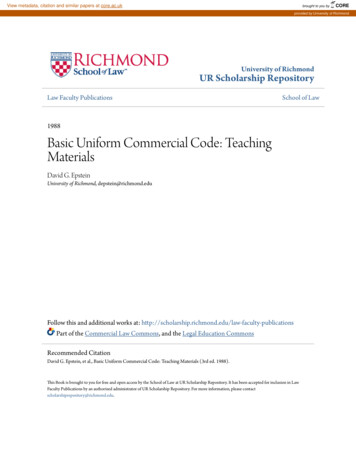
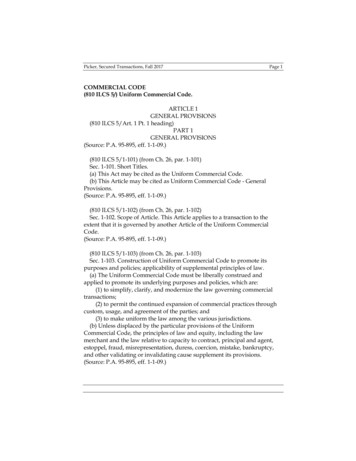
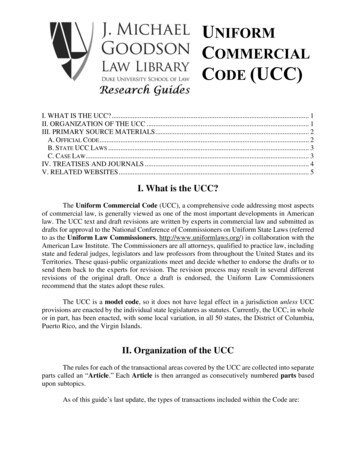
![Solar Code Development v2.5 [Read-Only]](/img/63/solar-20code-20development-20vfinal.jpg)
